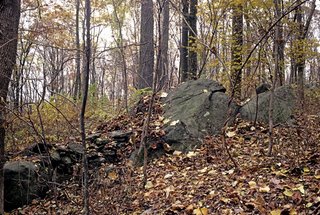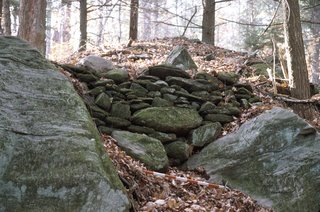The Oley Hills site in eastern Pennsylvania actually consists of three sites on one ridge. Two of them have been briefly discussed in my NEARA article, “Stone Rows and Boulders” (http://www.neara.org/Muller/stonerows.htm). They are the Central Ridge Site, which has the large boulder on the ridge crest, and the South Ridge Site, which is at the very end of the ridge. Both are bookends to the third site, the Terraced Boulders Site (Fig. 1), which is halfway between the other two, and has not been described earlier. As with the first two, this one is also on private land and its location cannot be divulged.
The Terraced Boulders Site consists of a small grouping of three features, all clustered within an area of 360 square feet. It is considerably different from the other two sites on the Oley Hills ridge, in that the focus here is on the “terracing” of certain features with piled stones, something that is not found at either of the other two sites discussed previously. At feature “A” in Fig. 1 is a large rounded boulder, approximately 12’ long. When I first saw this seven years ago, the surface was covered with briars and vines, and the piled stonework was nearly invisible. But with some clipping and pulling, I was able to clear away the vines (and poison ivy), and reveal the boulder and stonework in all its glory (Fig. 2). I had never before seen this kind of stonework, and it remains unique. What it all means, however, I have no idea. The stonework is clustered mostly on the southeast side of the boulder; this may be significant.
The next feature, “B,” is the most unusual one at the site, and consists of a grouping of about three boulders, all enhanced with stonework that wraps around it and fills voids (Fig. 3).
The outline can be best visualized by a line drawing I made of it (Fig. 4).
Note the large boulder to the far right with the small boulder on top. From this view point, it reminds me of a turtle head at a 45° angle, and this could be why this boulder complex was singled out for attention – again the simulacra effect.
As one walks around the boulder clockwise to the east, one comes to a curious stone V-fill between two boulders (Fig. 5 and 6).
This reminded me of another fill I saw at the South Ridge Site (Fig. 7),
which again was similar to one I have seen in Newfane, VT (Fig. 8).
All of these examples are variations on the same theme: an aesthetically pleasing joining of two forms with a stone fill that also might have female symbolism.
The “turtle head” boulder from this side looks quite different, and on top was placed a small boulder that is shimmed with a smaller stone to keep it in place (Fig. 9).
We see this kind of emphasis over and over again throughout the Northeast, where some unusual looking boulder or stone feature has a smaller stone or stones on top of it.
Feature “C” is the last in this group of three, and rather enigmatic (Fig. 10). It consists of a carefully built stone terrace that frames the some large boulders in back, one of which has a large vertical crack or void in it. This feature could be the reason for this construction, in that cracks, voids or caves were entrances to the underworld and also had associated female symbolism. We also saw this association in Figures 5 & 6.
Subscribe to:
Post Comments
(
Atom
)










1 comment :
Norman:
I know one example of a pile wrapping up the side of a boulder that way.
Peter
Post a Comment